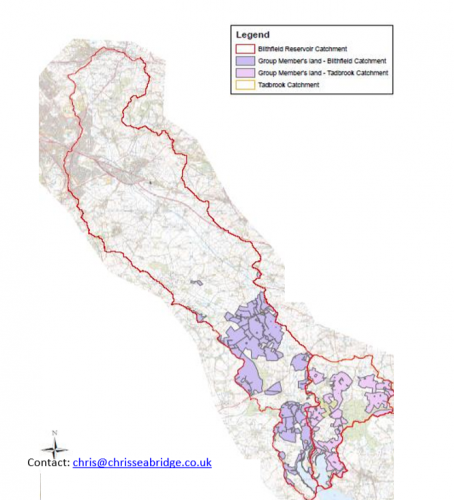Ref: CSFF060006
Lead: Chris, Chris@chrisseabridge.co.uk
Group members: 31
Length of agreement: 5
Area of group (Hectares): 4043
The Blithfield Reservoir catchment crosses the Needwood and South Derbyshire Claylands Priority Area (NCA 068) and the Potteries & Churnet Valley Priority Area (NCA 064). We will focus on top priorities common to both:
- Priority Habitats: a) Maintenance and enhancement of floodplain grazing marsh alongside the River Blithe (some of which is species-rich grassland) and fen/ reedbed habitat adjacent to Blithfield Reservoir. b) Blithfield Reservoir is designated a SSSI for its value to wildfowl. We will aim to further reduce agricultural diffuse pollution with a positive impact on priority habitats. Blithfield Reservoir is eutrophic, so reducing nutrient inputs from agriculture will reduce the potential for algal blooms, with their subsequent impact on aquatic habitats.
- Priority Species: Management of floodplain grazing marsh together with appropriate use of grassland/arable options and capital items will benefit populations of priority farmland birds, in particular ground nesting wader species including lapwing and curlew (recorded throughout the catchment). Turtle dove has been recorded in the vicinity of Blithfield Reservoir where there is potential to enhance both nesting and foraging habitat.
- The whole of the catchment area lies in a hot spot for the Farmland Package of options for pollinators. Members will be encouraged to provide year round nesting, resting and foraging habitat for pollinators.
- Woodland planting. There is potential for woodland planting as a means of reducing diffuse pollution, enhancing biodiversity (particularly extending/buffering priority woodland habitat) and reducing flood risk along the River Blithe.
- Landscape: Maintenance and restoration of hedgerows, hedgerow trees, infield trees, bank-side trees (NCA 068) and ponds.
- Many of the biodiversity options will also provide resource protection benefits. Water quality priorities that will be addressed include reducing agricultural nitrate, phosphate and pesticide losses. There are synergy benefits from addressing these two issues together as poor water quality is known to adversely impact on biodiversity.

